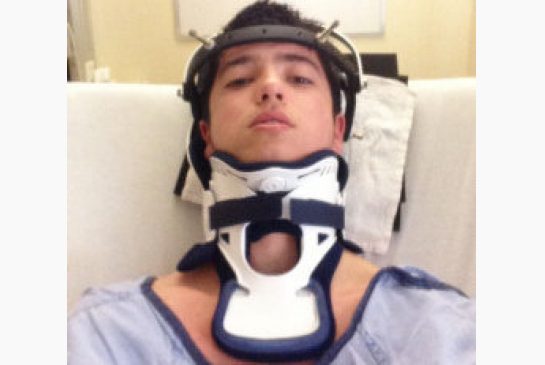Three cheers for our heroic Lifeguards! In this episode, I get the opportunity to speak with Logan Evans, the Life Guard who was part of a three person team of First Aid providers who helped a woman who had apparently had a seizure and fallen in the Women’s shower room at a local pool! The problem was that there was a pool full of people and the patient was trapped in a locked shower stall half in and half out of the door on the ground. Watch this interview to see how Logan, Certified Lifeguard, sprung into action to help this person through this scary and potentially life threatening situation.
Category Archives: Patient Assessment

How Do I Treat Neck Injuries On The Ice?
In this episode we answer a question that was sent in by a Rescue Fan that wondered what the best course of action would be if a person suffered a neck injury on the ice. It’s important to remember that if the patient has any pain, movement minimization is the goal while maintaining the patients core body temperature while waiting for EMS to arrive. If the person doesn’t feel hurt, they may elect to slowly get to their feet and recover. If they do feel pain, numbness, tingling, weakness or loss of consciousness, the best course of treatment  in my opinion is to call 911 or EMS. I hope it helps.
in my opinion is to call 911 or EMS. I hope it helps.
“Why Are There Different Names For Different Pulses?”
Today I had a great question come in through our customer solutions department. Here’s what it said.
“What and why are the pulses of different ages called different things and what are they called?”
Well, I understood this to mean, what are the different locations for the different age groups in cardiac arrest or unconsciousness and so I gave the following answer.
Hello,
Thank you so much for your question. It’s a great question and I think I might be able to shed some light on it.
It can be a little confusing some times as we try and decode the reason why certain things in medicine are named what they are. Basic Life Support is not immune to this same situation. In regards to the names of “pulses” and how they are named according to the age or size of the patient, I’ll try to clarify.
If I understand your question correctly, you’re talking about the three locations of the pulse check.
1. Radial, which is found in the wrist of the patient, usually used for patients who are adult or child size. Older than 1 year of age. This location is used for general pulse rate and quality but not usually for the unconscious patient.
2. Brachial, which is found in the bicep/tricep region of the upper arm on the inside of the arm. This is the location for an unconscious infant, age 1 year or younger.
3. Carotid, which is found in the neck. This would be located between the trachea and the sternocleidomastoid muscle(located on the side of the neck). One can really see this muscle well when one turns their head to one side or the other. This would be the location of choice for the adult and child(older than 1 year) unconscious patient.
There is yet another location used in emergency medicine but not usually pre-hospital and that would be the femoral artery. This is located in the groin of the patient and again is usually used for trauma patients that have C-Spine collar or the carotid is not easily accessed due to intubation etc.
The reason to use the brachial over the carotid for an infant is primarily due to the fact that most baby’s don’t have necks to speak of. They have milk catching folds of skin but other than that, their anatomy is such that an area to evaluate an accurate carotid pulse is not easily obtained. Therefore, the brachial artery is the location of choice and works extremely well for the health care professional to ascertain whether a pulse is present or absent.
In most cases for adults and children over the age of 1 year, the carotid artery is the location of choice to check for pulse presence due to it being the last place to feel a pulse prior to the blood pressure being too low to feel a pulse regardless of whether the heart is beating or not. Secondly, it’s next to the location where we are performing a head tilt and chin lift while giving rescue breaths and is convenient to the rescuer for checking pulse presence(little perk).
So, though the names of the locations can be a little challenging, they do make great scrabble words, or can make you look really intelligent at dinner parties. Remember, it’s not the feeling of a pulse that will determine if we’re going to start cardiac compressions or not, It’s the absence of signs of life that will determine that. This includes, unconscious and unresponsiveness and that the patient is not breathing normally or not breathing at all. If these two signs are present, begin CPR. Pulse checks have often given false readings and postponed cardiac compressions in a patient who needed cardiac compressions desperately.
I hope this helps anyone who may have had the same question.
Best wishes and keep on rescuing!
Roy
RoyOnRescue.com
—
Roy W. Shaw, EMT-Paramedic
Director of Training and Compliance
ProTrainings.com
AVPU for Deciding to Start CPR?
In this episode of RoyOnRescue, Roy offers an answer to an email question about using the assessment of Awake, Verbal, Painful Response, Unconscious(AVPU) method for deciding to begin CPR. He sheds some light on what AVPU is and how it can be blended with the guidelines to decide to start CPR.
“Head and Shoulders, Knees and Toes…”
A student emailed a question regarding the Head to Toe exam. Though this is normally performed as a secondary survey in a more advanced setting, I do think there are times where knowing how to check a person for other injuries is a good idea. Take a look at the video blog and I hope this helps.
Best Wishes,
Roy
Shock and the Capillary Refill Test
In this RoyOnRescue Video Blog, a student had emailed Roy a question about explaining the Capillary Refill Test and how it may relate to determining if someone is suffering from shock.
Be sure to watch this episode of RoyOnRescue and learn a new trick that could either tell you if someone is going into shock, or that their hands are simply cold.
There are three main reasons why a person may have more than a 2 second capillary refill time:
1. Shock
2. Peripheral Vascular Disease
3. Hypothermia or cold hands
This slow capillary refill time of more than 2 seconds should only be an indication that we should check for other problems. Please don’t assume simply because someone has a slow cap. refill that they are going into shock. It is simply a quick and easy test to help point a first aider in the right direction and to tell us we should check for other issues.

